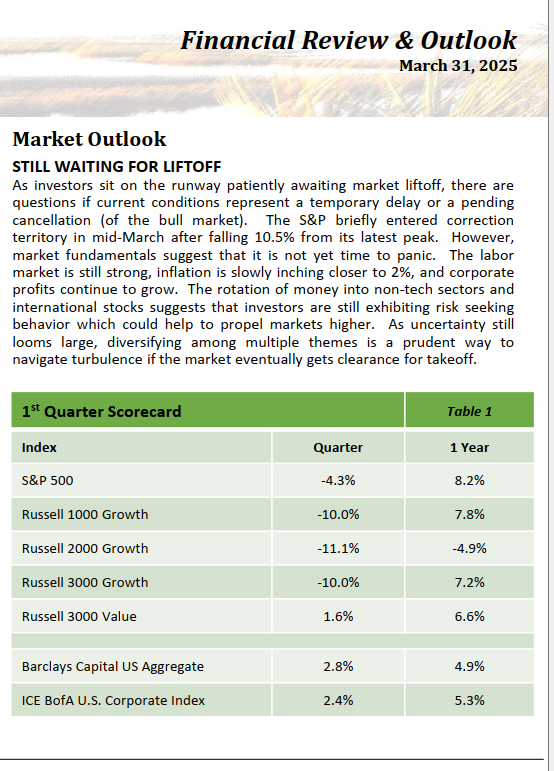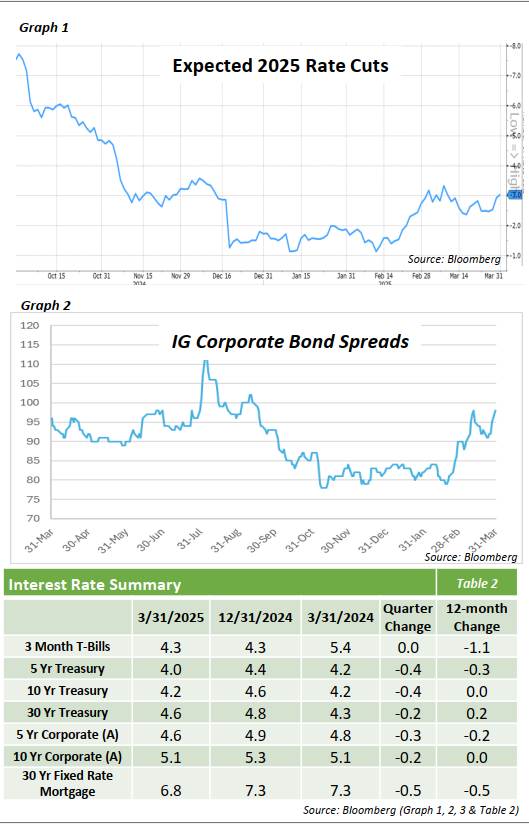Equity Overview
BROADENING MARKET
The S&P 500 sold off 4.3% in Q1 as escalating uncertainty around trade policy and economic growth caused steady profit taking soon after all time highs were reached in mid February. Evidence of a broadening market was observed as the equal-weighted S&P 500 outperformed for the 2nd time in three quarters. Small cap stocks struggled under threats of reciprocal tariffs and delayed interest rate cuts. Risk-seeking investors rotated into international stocks which rallied strongly, particularly in Europe and China.
TARIFFS TAX INVESTOR NERVES
The prospect of tariffs was well telegraphed by President Trump on the campaign trail. However, Trump’s frequent changes to the target countries and suggested amounts of tariffs came as a shock. Surprise announcements of tariffs for Canada and Mexico in late January, retaliatory tariffs for Europe and China in February, and potential oil tariffs for Russia in late March added to the market’s anxiety.
DEEPSEEK DERAILS A.I. TRADE
Perhaps the biggest shock to the market outside of tariffs was the reveal of DeepSeek, a lower cost alternative AI model from China. Doubts over DeepSeek’s validity were overshadowed by doubts about the payoffs of increased AI investments should further competition emerge. Earnings season was littered with conservative profit guidance as corporations struggled to confidently project growth prospects in such a fluid cost environment.
DOGE ACTIONS, FED INACTION ADD TO VOLATILITY
The first round of job cuts from the Elon Musk-led Department of Government Efficiency increased anxiety about the future stability of the labor market. Investors waiting on rate cuts from the Fed to spur a rebound rally were disappointed as hotter than expected inflation numbers have the Fed content to wait. Typically, rate hikes, not cuts, end bull markets so market impact from the Fed’s patience should be muted.
Market Outlook
STILL WAITING FOR LIFTOFF
As investors sit on the runway patiently awaiting market liftoff, there are questions if current conditions represent a temporary delay or a pending cancellation (of the bull market). The S&P briefly entered correction territory in mid-March after falling 10.5% from its latest peak. However, market fundamentals suggest that it is not yet time to panic. The labor market is still strong, inflation is slowly inching closer to 2%, and corporate profits continue to grow. The rotation of money into non-tech sectors and international stocks suggests that investors are still exhibiting risk seeking behavior which could help to propel markets higher. As uncertainty still looms large, diversifying among multiple themes is a prudent way to navigate turbulence if the market eventually gets clearance for takeoff.

Fixed Income Overview
Safety Found Within Bonds
As the new administration took office in January, there was no hesitation in terms of policy announcements and the markets reacted quickly in response to the multitude of factors that came forward throughout the quarter. Tariffs, DOGE, tax cuts and geopolitical events were just some of the headline issues that impacted markets. Bonds, for the most part, played the safe-haven role and the Bloomberg Aggregate was up 2.8% for the quarter.
Inflation, while in recent times had shown signs of being subdued, is becoming an area of concern once again as the threat of tariffs continues to hover over the economy. Treasury Secretary Scott Bessent has made various statements that he wants to keep the 10-Year Treasury rate low, but his goal may become difficult if price increases filter through the economy in a substantial way.
Throughout the recent uncertainty, rates have come down but appear to be attempting to find a sense of direction as both inflation and the risk of a recession could pull them in contradictory ways. The 2-year, 10-year and 30-year Treasuries were down 36bps, 36bps and 21bps respectively.
The Fed is in a conundrum of focusing on the inflation risks or the potential of an economic slowdown, and what that could mean for monetary policy. The market is still pricing in three cuts for the rest of the year (graph 1), indicating a belief that a looser monetary policy may be order but this could be upended if price increases begin to filter through in a substantial way.
A sell-off in risk assets was evident within the corporate bond space and, coming off historic tights, investment-grade spreads began to show some cracks and widened out by 12bps for the quarter (graph 2). The widening in corporate bonds was more pronounced in lower quality issuers as high yield spreads widened out by 55bps.
Despite the economic and policy uncertainties, it is reassuring to see bonds behave as a safe-haven and generate a solid return for the quarter. There are still many unknowns that the markets will be faced with going forward, and the necessity of high-quality assets within the bond space could be of utmost importance.
Opinions expressed herein are subject to change.

